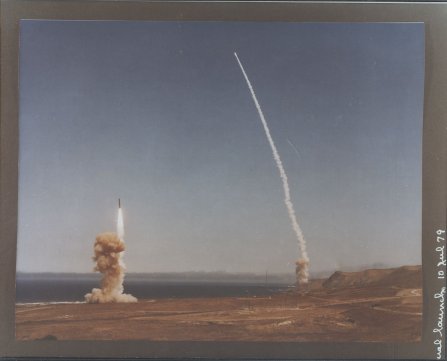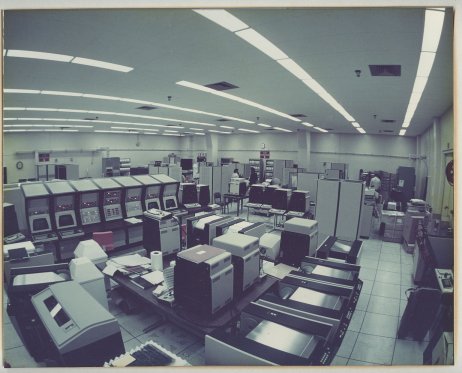minicomputers
Systems Engineering Laboratories, Inc. [SEL]
The installation is located in
building 7000 at Vandenberg Air Force Base here in Santa Barbara
county, California. VAFB is a very large Air Force Base and at one
time, was equipped to handle the Space Shuttle. Most of the base
facilities are used to launch pay loads and testing of ICBM's. There
are a half dozen really large launch pads and an unknown number of
other launch sites for missal testing.
The purpose of the Telemetry Integrated Processing System [pdf] is to process, record, and display telemetry data in real time for the U.S. Air Force Western Space and Missile Center (WSMC). TIPS also processes the telemetry data from vehicles that are launched at other facilities around the world. Some of this data is from aircraft. TIPS also records and decomutates the necessary data to comply with the Russian Salt Treaty. This data is shared with the Russians. The system has been in continuous operation since 1977. TIPS has never missed a scheduled launch, to this day.
In the original configuration, TIPS consisted of 21 systems of the SEL 32/55 and 32/75A computers, 2 systems of the CDC Cyber 840 computers, and various peripheral and supporting equipment on 2 acres of floor space.
For a typical launch support, which would be for a Minuteman missile -- these usual go in the middle of the night and they are relatively quiet. You can only hear them for about 20-30 miles away and they make lots of light and nice to watch. It takes several weeks to get the missile ready and installed in the launch facility. After installation, there is a long period of testing, and when all is well, the launch is scheduled. There are lots of things besides TIPS and the vehicle involved with the launch. Weather is always a big deal.
On launch night, everything is brought on line and tested. At a certain point, Data Acquisition is turned on, all equipment is checked, Data Recording is turned on and the missile is launched. The vehicle data is received by TARE and distributed to all of the systems. In the mean time, the vehicle makes it's trip to Kwajulean. This normally takes 916 seconds for the 4000 mile trip. The data is then distributed to the users, where it is processed in real time and recorded for further playback.
The purpose of the Telemetry Integrated Processing System [pdf] is to process, record, and display telemetry data in real time for the U.S. Air Force Western Space and Missile Center (WSMC). TIPS also processes the telemetry data from vehicles that are launched at other facilities around the world. Some of this data is from aircraft. TIPS also records and decomutates the necessary data to comply with the Russian Salt Treaty. This data is shared with the Russians. The system has been in continuous operation since 1977. TIPS has never missed a scheduled launch, to this day.
In the original configuration, TIPS consisted of 21 systems of the SEL 32/55 and 32/75A computers, 2 systems of the CDC Cyber 840 computers, and various peripheral and supporting equipment on 2 acres of floor space.
For a typical launch support, which would be for a Minuteman missile -- these usual go in the middle of the night and they are relatively quiet. You can only hear them for about 20-30 miles away and they make lots of light and nice to watch. It takes several weeks to get the missile ready and installed in the launch facility. After installation, there is a long period of testing, and when all is well, the launch is scheduled. There are lots of things besides TIPS and the vehicle involved with the launch. Weather is always a big deal.
On launch night, everything is brought on line and tested. At a certain point, Data Acquisition is turned on, all equipment is checked, Data Recording is turned on and the missile is launched. The vehicle data is received by TARE and distributed to all of the systems. In the mean time, the vehicle makes it's trip to Kwajulean. This normally takes 916 seconds for the 4000 mile trip. The data is then distributed to the users, where it is processed in real time and recorded for further playback.
photo 1 (declassified)
In photo 1, only about 20 percent of the delivered system is visible in the camera view since it's a large installation. In the center of the photo, you can see the system control console with 7 cabinets consisting of 4 ADM-2 terminal units and 3 operator control consoles. The equipment behind the control console is a CDC Cyber 840 that is used for generating run time files and on line numerical processing. The equipment in the right center is a SEL 32-55 Mass Storage Controller and a SEL 32-55 Configuration Interface Controller. The equipment in the foreground is High Speed Printer Plotters, Plasma Display units and various peripherals connected to a SEL 32-55 Quick Look Display computer, which happens to be out of sight to the left of the line printer.

photo 2 (declassified)
In photo 2, a dual Minute Man missile launch is shown from 1979. TIPS successfully recorded and processed the telemetry data in real-time from this launch. This operation had never been possible before TIPS.

